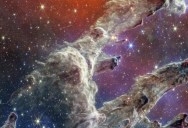“Pillars of Creation” Combined Image From JWST is Breathtakingly Beautiful
In October 2022, NASA’s James Webb Space Telescope (JWST) captured highly detailed images of the Pillars of Creation, first observed by the Hubble Space Telescope in 1995. The new JWST images have been combined into a stunning 3D glimpse of the iconic pillars, at times appearing almost transparent, where new stars are forming.

Photo Credit: NASA, ESA, CSA, STScI. Image Processing: Joseph DePasquale (STScI), Alyssa Pagan (STScI), Anton M. Koekemoer (STScI)
Two cameras aboard the JWST, the Near-Infrared Camera (NIRCam) and the Mid-Infrared Camera (MIRI) shot the Pillars of Creation in different shades of light. Almost every element in the combined shot is from the Eagle Nebula, a large gas cloud approximately 6,500 light years away.
The NIRCam images captured the newly formed stars as bright red orbs that often have diffraction spikes and lie outside one of the dusty pillars. The MIRI snaps show the layer of hot and cold dust and hot dust shooting from the pillars’ layers as well as the orange and purple waves that shield the view from more distant light.

Photo Credit: NASA, ESA, CSA, STScI; Joseph DePasquale (STScI), Anton M. Koekemoer (STScI), Alyssa Pagan (STScI)
In addition to their breathtaking beauty, images from space telescopes provide researchers with valuable information about how stars form and behave. The most interesting features in the new JWST photos are the lava-red waves at the edges of the pillars, especially the middle one. These are supersonic jet ejections from the youngest stars that collide with the pillars and are thought to be a few hundred thousand years old.
The majestic pillars, first made famous in 1995 and revisited in 2014, will likely be studied by the latest technology for many years to come.

Sign up to get our BEST stories of the week straight to your inbox.




